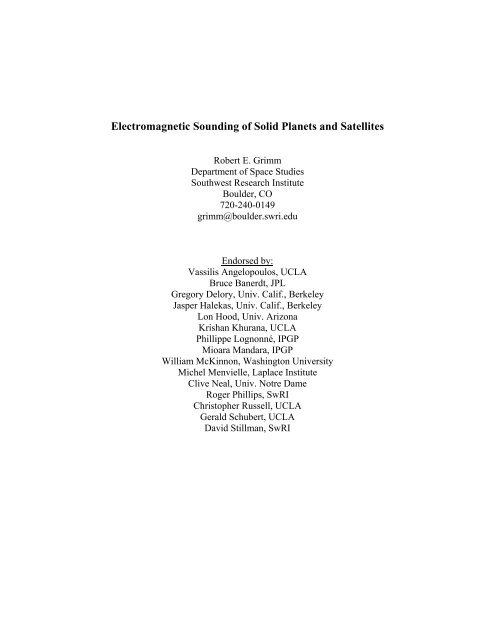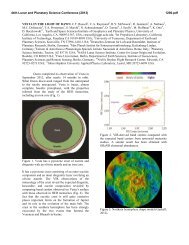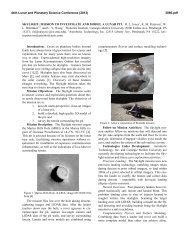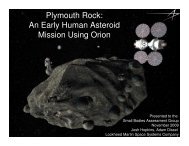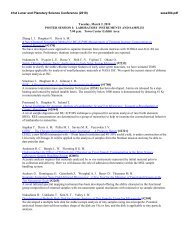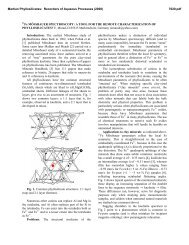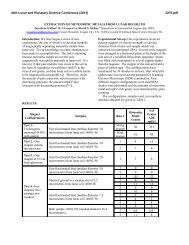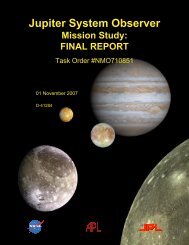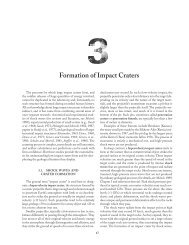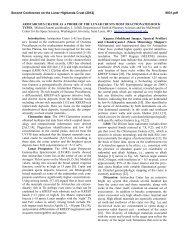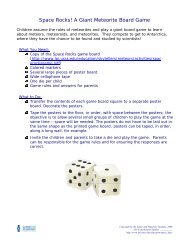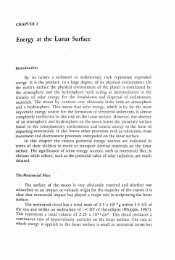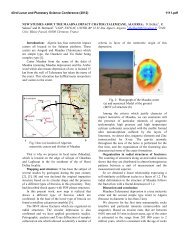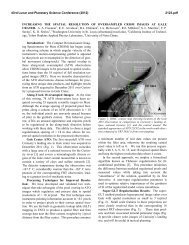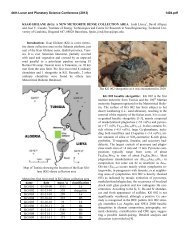Electromagnetic Sounding of Solid Planets and Satellites
Electromagnetic Sounding of Solid Planets and Satellites
Electromagnetic Sounding of Solid Planets and Satellites
Create successful ePaper yourself
Turn your PDF publications into a flip-book with our unique Google optimized e-Paper software.
<strong>Electromagnetic</strong> <strong>Sounding</strong> <strong>of</strong> <strong>Solid</strong> <strong>Planets</strong> <strong>and</strong> <strong>Satellites</strong><br />
Robert E. Grimm<br />
Department <strong>of</strong> Space Studies<br />
Southwest Research Institute<br />
Boulder, CO<br />
720-240-0149<br />
grimm@boulder.swri.edu<br />
Endorsed by:<br />
Vassilis Angelopoulos, UCLA<br />
Bruce Banerdt, JPL<br />
Gregory Delory, Univ. Calif., Berkeley<br />
Jasper Halekas, Univ. Calif., Berkeley<br />
Lon Hood, Univ. Arizona<br />
Krishan Khurana, UCLA<br />
Phillippe Lognonné, IPGP<br />
Mioara M<strong>and</strong>ara, IPGP<br />
William McKinnon, Washington University<br />
Michel Menvielle, Laplace Institute<br />
Clive Neal, Univ. Notre Dame<br />
Roger Phillips, SwRI<br />
Christopher Russell, UCLA<br />
Gerald Schubert, UCLA<br />
David Stillman, SwRI
1. Introduction<br />
<strong>Electromagnetic</strong> (EM) sounding encompasses a wide variety <strong>of</strong> methods used to sense<br />
subsurface structure from less than a few meters to a thous<strong>and</strong> kilometers or more. EM sounding<br />
is distinct from surface-penetrating radar in being inductive rather than wavelike; the diffusive<br />
transfer <strong>of</strong> energy is akin to that in heat flow, groundwater, <strong>and</strong> electrical circuits. This transition<br />
to induction occurs at low frequency where the loss tangent exceeds unity, in the kilohertz to<br />
megahertz range depending on ground electrical conductivity. A vast underworld <strong>of</strong> the EM<br />
spectrum, from below one microhertz to perhaps one megahertz, is therefore the continuous<br />
realm <strong>of</strong> EM sounding. Recent work aimed at large-scale terrestrial geodynamics spans the<br />
hydration state <strong>of</strong> the upper mantle (1,2), melting on the 410-km discontinuity (3), heterogeneity<br />
in lithospheric structure across Europe (4), <strong>and</strong> the nature <strong>of</strong> accreted crust in Canada (5,6). EM<br />
methods have been used for decades in mining exploration (7,8) <strong>and</strong> have recently seen a major<br />
surge in oil <strong>and</strong> gas exploration (9). Yet EM exploration can be simple enough to be widely used<br />
in environmental <strong>and</strong> engineering applications (10).<br />
There have been only two campaigns <strong>of</strong> EM sounding in the history <strong>of</strong> planetary exploration:<br />
use <strong>of</strong> l<strong>and</strong>ed <strong>and</strong> orbital measurements to determine the general interior properties <strong>of</strong> the Moon,<br />
particularly to constrain the size <strong>of</strong> a conductive core (e.g., 11-14), <strong>and</strong> the discovery <strong>of</strong> the<br />
highly conductive internal oceans <strong>of</strong> the icy jovian satellites (15) with the Galileo spacecraft. Yet<br />
potential applications abound, over a comparable or greater range <strong>of</strong> depths than the Earth:<br />
buried ice on Mercury, Mars, <strong>and</strong> the Moon; groundwater on Mars, ice-shell thicknesses <strong>and</strong><br />
brine contents <strong>of</strong> icy satellites, lithospheric thicknesses on Mercury, Venus, <strong>and</strong> the Moon, <strong>and</strong><br />
by inference, geothermal gradients; <strong>and</strong> impurity content <strong>of</strong> silicate mantles, particularly water.<br />
The purpose <strong>of</strong> this White Paper is to provide some background <strong>and</strong> guidance on the<br />
applicability <strong>and</strong> requirements <strong>of</strong> EM methods for investigating the interiors <strong>of</strong> many solid<br />
bodies in the Solar System. A large number <strong>of</strong> general endorsements was not sought; rather, the<br />
signatories largely reflect a cross-section <strong>of</strong> experienced geophysicists <strong>and</strong> space physicists,<br />
particularly those in low-frequency electromagnetics. Although this document can be considered<br />
reference material for White Papers on l<strong>and</strong>ed networks for Mars (16) <strong>and</strong> the Moon (17),<br />
specific missions are not advocated here. Rather, it is intended to inform panel deliberations that<br />
might be considering interior investigations about what can done with EM sounding <strong>and</strong> what<br />
measurements are necessary.<br />
2. Principles <strong>of</strong> EM <strong>Sounding</strong><br />
Useful summaries <strong>of</strong> EM geophysics abound (e.g., 7,8,18); this paper focuses on the essential<br />
elements relevant to planetary exploration.<br />
2.1 Material Properties. The complex dielectric permittivity * <strong>and</strong> complex permeability<br />
* are the constitutive parameters <strong>of</strong> all electromagnetics. The latter rarely differs from its freespace<br />
value <strong>and</strong> will be neglected hereafter. The real part <strong>of</strong> *, when normalized by the freespace<br />
value, is the dielectric constant, which in turn is the square <strong>of</strong> the real refractive index. It<br />
measures storage <strong>of</strong> electrical energy. The imaginary part <strong>of</strong> * depends on the conductivity <br />
<strong>and</strong> measures loss <strong>of</strong> electrical energy. A complex conductivity contains the same information as<br />
complex permittivity with the storage <strong>and</strong> loss in the imaginary <strong>and</strong> real parts, respectively. The<br />
complex permittivity is frequency dependent in the vicinity <strong>of</strong> dielectric relaxations. Such<br />
behavior is important in rocks containing certain minerals (8,19) or H2O (as liquid, solid, or<br />
1
hydrate; (8,20-23) but in truly dry rock—lacking even surface-adsorbed water—the frequency<br />
dependence is weak (e.g., 20,24).<br />
Electrical conduction in the familiar sphere <strong>of</strong> Earth’s upper crust is largely electrolytic, i.e.,<br />
by movement <strong>of</strong> ions in water—conductivity increases with porosity <strong>and</strong> solute content, as in the<br />
classic Archie’s Law (8,10). In subeutectic frozen H2O systems, conduction through ice <strong>and</strong><br />
hydrates is protonic, through charge defects resulting from lattice substitutions <strong>of</strong> salts, acids,<br />
<strong>and</strong> bases (21-22). Analogous substitutions by iron, aluminum, oxygen, <strong>and</strong> hydrogen in silicates<br />
result in electronic semiconduction, both from electrons <strong>and</strong> holes (25). Conductivity is also<br />
strongly temperature dependent, with Ahrennius activation energies in the eV range.<br />
Table 1 gives some representative conductivities for planning purposes. The most striking<br />
feature is that the outer portions <strong>of</strong> all other silicate or icy bodies in the Solar System are likely to<br />
be much more resistive than the Earth, for the simple reason that free water is lacking. This<br />
opens up these regions to EM sounding at higher frequencies (see below), which in turn provides<br />
better measurements <strong>and</strong> more convenient signal integration.<br />
Table 1. Representative Solar-System DC Electrical Conductivities (1,3,8,10,11,22,26)<br />
Material , S/m Material , S/m<br />
Typical Earth Crust 10 -2 Mars dry crust 10 -2 ?<br />
Massive rock 10 -4 Cold ice (
2.3 Active vs. Passive Methods. Within the low-frequency branch <strong>of</strong> diffusive EM, the<br />
primary division is between those that use an artificial source (a transmitter) <strong>and</strong> those that rely<br />
on natural sources. The former enjoy considerable flexibility <strong>and</strong> high signal-to-noise but require<br />
significant additional resources. Terrestrial exploration depths using multi-kilometer setups <strong>and</strong><br />
massive generators <strong>and</strong> typically have been limited to several kilometers. The higher resistivities<br />
<strong>of</strong> other silicate <strong>and</strong> icy bodies (Table 1) would, however, enable active seeking <strong>of</strong> conductive<br />
targets (e.g., water) at depths <strong>of</strong> a few kilometers using more modest resources (28). However,<br />
the best use <strong>of</strong> an active system is to perform a geometrically controlled sounding (see below) to<br />
determine the complex conductivity in the very shallow subsurface, say ice in the top several<br />
meters <strong>of</strong> the Mars or the lunar poles (29). Otherwise, soundings from 1000 km can<br />
be performed with minimal resources using natural sources. On Earth, abundant energy exists 10 4 Hz<br />
Mercury <br />
Venus <br />
Earth Ring Current<br />
Moon <br />
Mars (crustal) <br />
Interplanetary <br />
Jupiter Inclined Static Field<br />
Saturn (Titan) (Titan)<br />
2.4 Parametric vs. Geometric Methods. The second main division in low-frequency EM is<br />
whether the source is horizontally separated from the receiver by greater than or less than a skin<br />
depth. The former case <strong>of</strong> large induction number corresponds to natural-source soundings as<br />
well as large-<strong>of</strong>fset artificial-source methods. Here exploration depth varies parametrically, i.e.,<br />
with frequency, soundings are performed by inverting impedance as a function <strong>of</strong> frequency for<br />
conductivity as a function <strong>of</strong> depth (see below). Conductivity is assumed to be real <strong>and</strong><br />
independent <strong>of</strong> frequency. Where the receiver is within a skin depth <strong>of</strong> the transmitter (small<br />
induction number), exploration depth increases with transmitter-receiver <strong>of</strong>fset, <strong>and</strong> geometric<br />
soundings are performed by inverting impedance as a function <strong>of</strong> <strong>of</strong>fset to conductivity as a<br />
function <strong>of</strong> depth. While sharply limited in investigation depth to about 1/3 <strong>of</strong> the maximum<br />
transmitter-receiver separation, geometric soundings have the advantage <strong>of</strong> being able to solve<br />
for the frequency dependence <strong>of</strong> complex conductivity.<br />
3
2.5 Measurements. The fundamental quantity that must be derived in any sounding is the<br />
frequency-dependent EM impedance Z, <strong>and</strong> it is the variety <strong>of</strong> approaches to Z that lead to more<br />
individual techniques in EM than in any other geophysical method (31). The impedance is<br />
related to the apparent resistivity athe most commonly used parameter because <strong>of</strong> its<br />
dimensional analog to true resistivityas a = Z 2 /, where is the permeability <strong>and</strong> is the<br />
angular frequency. Alternative EM response parameters such as the admittance or the transfer<br />
function can also be related to Z (32,33).<br />
Two known quantities are necessary to determine the impedance, e.g., Ohm’s Law Z =<br />
V/I (see Table 4). One <strong>of</strong> those quantities is nearly always the magnetic field B near the target,<br />
i.e., the sum <strong>of</strong> source + induced magnetic fields. Note that this first platform need not be on the<br />
surface, but can be a spacecraft within about one skin depth at the highest frequency <strong>of</strong> interest.<br />
In a variety <strong>of</strong> Transfer-Function (XF) methods, the second known quantity is the source<br />
magnetic field. This is straightforward for an artificial transmitter, or, in passive measurements,<br />
the source is measured by a second, distant spacecraft, as was done for Apollo-era lunar<br />
soundings (11,12,14). In a few special cases <strong>of</strong> accurately characterized natural signals—the<br />
Earth’s ring current (34) or the time variation introduced by the motion <strong>of</strong> the Galilean satellites<br />
in Jupiter’s main field (15)—the source can be specified a priori, so a single platform is<br />
sufficient. Single-magnetometer characterization can also be performed where the target can be<br />
approximated as a perfect conductor, like the Moon’s core (e.g., 13).<br />
Geomagnetic Depth <strong>Sounding</strong> (GDS) uses surface arrays <strong>of</strong> magnetometers to determine<br />
impedance from the ratio <strong>of</strong> vertical B to the magnitude <strong>of</strong> the horizontal gradient <strong>of</strong> B (35).<br />
Because the wavelength in the ground = 2, GDS requires array spacing comparable to the<br />
skin depth in order to resolve the relevant horizontal wave structure. This calls for dense arrays<br />
to resolve the outer tens to hundreds <strong>of</strong> kilometers <strong>of</strong> planetary bodies. However, the wavelength<br />
can be specified when diurnal signals <strong>and</strong> their low-order harmonics are detected, such as daily<br />
variations <strong>of</strong> the ionosphere. As with the other special cases discussed above, this approach can<br />
provide single-station soundings over a limited frequency range. On the other h<strong>and</strong>, the electric<br />
field E can supply the required second piece <strong>of</strong> information, <strong>and</strong> enable complete EM soundings<br />
from a single station.<br />
Table 4. Approaches to Natural-Source EM <strong>Sounding</strong><br />
Method Measurements Num. <strong>of</strong> Stations Comments<br />
Transfer Function (XF) Magnetic Field B 2 Determine source field by distant<br />
2 nd stn. unaffected by target<br />
Transfer Function-1 (XF-1) B<br />
1<br />
Special case using prior knowledge<br />
<strong>of</strong> source-field strength OR<br />
target is “perfect” conductor<br />
Geomagnetic Depth <strong>Sounding</strong> B 3 or more Compute impedance from vertical<br />
(GDS)<br />
field <strong>and</strong> horizontal gradients<br />
Geomagnetic Depth <strong>Sounding</strong> B 1 Special case where horizontal<br />
(GDS-1)<br />
gradient can be computed using<br />
diurnal periods <strong>and</strong> harmonics.<br />
Magnetotellurics (MT) B + Electric field 1 General single-station method<br />
Wave Tilt (WT) Electric field 1 General single-station method<br />
The magnetotelluric method (MT) uses orthogonal horizontal E <strong>and</strong> B to form a plane-wave<br />
impedance, which applies not only locally but can be transformed to spherical geometry, i.e., to<br />
planetary scale (36,37). The wave-tilt method (WT) is preferred for aerial surveys because the<br />
quadrature horizontal E (containing most <strong>of</strong> the inductive signal) can be readily determined by<br />
4
comparison to the vertical E (38). Only B-field<br />
methods have been used heret<strong>of</strong>ore in<br />
planetary exploration because <strong>of</strong> their<br />
simplicity; E-field measurements are more<br />
challenging at low frequencies <strong>and</strong> noninductive<br />
contributions to E must be identified.<br />
Nonetheless, those methods using E have the<br />
significant advantage <strong>of</strong> complete soundings<br />
from a single vehicle that do not require a<br />
priori knowledge or special conditions.<br />
5. Interpretation<br />
In a parametric sounding, the impedance as<br />
a function <strong>of</strong> frequency is inverted to<br />
determine the conductivity as a function <strong>of</strong><br />
depth. Inverse methods are highly developed<br />
<strong>and</strong> robust (39,40). Resolution is geometric<br />
<strong>and</strong> is typically several percent <strong>of</strong> the depth.<br />
Overall, the thickness <strong>of</strong> a relatively resistive<br />
unit overlying a relatively conductive unit is<br />
well determined, whereas the thicknessconductivity<br />
product <strong>of</strong> a conductor overlying<br />
a resistor is recovered. Deep soundings<br />
usually fall in the former category, because<br />
increasing temperatures with depth dominate<br />
conductivity (e.g., Fig. 1). Saline water (Mars<br />
or icy satellites) is a near-ideal target.<br />
These vertical pr<strong>of</strong>iles can be interpreted<br />
directly, especially where major discontinuities<br />
are evident (e.g., 4-6). Advanced approaches<br />
use laboratory measurements <strong>of</strong> electrical<br />
conductivity to convert inverted quantities to<br />
subsurface temperature <strong>and</strong>/or composition<br />
(e.g., 1-3). Although the shallow subsurface<br />
can be very heterogeneous, there are a limited<br />
number <strong>of</strong> factors that can affect deep<br />
conductivity (see above). The increasing sophistication<br />
<strong>of</strong> interpretation leads to data<br />
products that fit NASA definitions (Table 5).<br />
Table 5. EM Data Products<br />
Level 1A Raw time series or spectra<br />
Level 1C Impedance vs. Frequency<br />
Level 2 Conductivity vs. Depth<br />
Level 3 Temperature/Composition<br />
vs. Depth<br />
5<br />
Figure 1. Lunar EM sounding interpreted using<br />
laboratory data (14). Top panel: Estimated<br />
limits on electrical conductivity vs. radius from<br />
magnetic transfer-function data. Middle panel:<br />
Laboratory temperature-conductivity data for<br />
pyroxenes, olivines, <strong>and</strong> a bulk model for the<br />
lunar interior below several hundred km.<br />
Bottom panel: Derived lunar temperature-depth<br />
pr<strong>of</strong>ile. Shaded area represents range <strong>of</strong><br />
temperature pr<strong>of</strong>iles based on electrical<br />
conductivity limits. Trace quantities <strong>of</strong> H2O in<br />
the lunar mantle can also meet temperature<br />
constraints without invoking high alumina (41).
6. Planetary Applications<br />
6.1 Mercury. A significant magnetosphere makes Mercury the most Earth-like in terms <strong>of</strong><br />
classical natural EM sources, yet frequent reconnection events (42) define an even more dynamic<br />
environment. It is not known if the XF method can be applied within a heterogeneous<br />
magnetosphere; MT from the surface or low orbit is complete from one spacecraft. Core size can<br />
be estimated from the static magnetic field, but as an excellent conductor the core will also be a<br />
prime EM target. The conductivity pr<strong>of</strong>ile in the mantle may determine whether it is convecting<br />
or whether the lithosphere takes up the entire mantle. The crustal thickness may be measured,<br />
although this conductor-over-resistor case is less precisely determined. Level 3 data may<br />
constrain the temperature pr<strong>of</strong>ile in the mantle, <strong>and</strong> hence the geothermal gradient. Iron content<br />
<strong>of</strong> the mantle may also be recovered.<br />
6.2 Venus. With a shielding ionosphere <strong>and</strong> no defined external sources, EM soundings <strong>of</strong><br />
Venus must be performed from the surface or atmosphere, using spherics (43) or ionospheric<br />
disturbances. Although measurements could be made in the hour or so lifetime <strong>of</strong> a l<strong>and</strong>er on the<br />
hot surface, aerial vehicles in the benign middle atmosphere can remotely sense the subsurface<br />
using MT or WT. A platform at 55 km altitude is sensitive to skin depths that significantly<br />
penetrate the lithosphere <strong>and</strong> hence can determine not only its thickness, but lateral variations<br />
over the ground track. This measurement is pivotal to underst<strong>and</strong>ing the geodynamic history <strong>of</strong><br />
Venus. Indeed, by correlating variations in EM penetration depth to topography, lithospheric<br />
thickness can be determined using Level 2 data, i.e., without reference to laboratory<br />
measurements (44). Dry-rock conductivities
gations, deep parametric EM can complement global objectives <strong>of</strong> seismology <strong>and</strong> heat flow<br />
<strong>and</strong>/or provide shallow geometric EM to assess ice content <strong>and</strong> other properties <strong>of</strong> the regolith.<br />
6.5 Asteroids <strong>and</strong> Comets. Small anhydrous bodies are likely sufficiently resistive that,<br />
barring heavy scattering, surface-penetrating radar would be able to probe globally. The<br />
presence <strong>of</strong> hydrated minerals <strong>and</strong> salt hydrates in aqueously altered objects, or higher<br />
temperatures in larger objects, may produce higher conductivities amenable to EM sounding.<br />
These solar-wind obstacles can be sounded with XF, MT, WT, <strong>and</strong> GDS methods, the last<br />
perhaps due to short diurnal periods. Time variations in the dielectric constant <strong>of</strong> subsurface ice,<br />
measured by geometric soundings, can map the diffusion <strong>of</strong> heat into the interior, either diurnally<br />
or as a comet approaches the sun.<br />
6.6 Giant-Planet <strong>Satellites</strong>. The extremely low-frequency time variations developed at the<br />
satellites <strong>of</strong> Jupiter by their inclined orbits with respect to the main field (15) will also be present<br />
at Uranus <strong>and</strong> Neptune. This will enable single-magnetometer global XF soundings for close<br />
flybys <strong>of</strong> satellites <strong>of</strong> the ice giants. Harmonics <strong>of</strong> these fundamental periods may also be<br />
present <strong>and</strong> their strengths determined a priori from the multipole expansion <strong>of</strong> the main field.<br />
Saturn’s satellites have negligible inclination with respect to the main field. For all the giant<br />
planets, however, the diversity <strong>of</strong> magnetospheric phenomena may provide a rich spectrum <strong>of</strong><br />
EM signals; at higher frequencies, ice-shell thicknesses <strong>of</strong> kilometers to tens <strong>of</strong> kilometers, <strong>and</strong><br />
the presence <strong>of</strong> brine intrusions into the shell, may be assessed. XF soundings may be<br />
appropriate if it can be demonstrated that fields will not be spatially aliased; otherewise l<strong>and</strong>ed or<br />
low-altitude MT can be used. Titan is <strong>of</strong> course different because <strong>of</strong> its atmosphere; like Venus,<br />
MT or WT measurements from l<strong>and</strong>ed or aerial assets could detect ionospheric disturbances or<br />
spherics. Long-period (16-day) signals also may be evident from diurnal ionospheric changes.<br />
7. Conclusion. <strong>Electromagnetic</strong> sounding incorporates a range <strong>of</strong> mature techniques used at all<br />
spatial scales in terrestrial subsurface exploration. Pioneering EM soundings <strong>of</strong> the Moon <strong>and</strong> icy<br />
satellites <strong>of</strong> Jupiter have demonstrated the potential <strong>of</strong> these methods for planetary science.<br />
8. References. (1) Yoshino et al., Nature, 443, 973, 2006. (2) Wang et al., Nature, 443, 977, 2006. (3) T<strong>of</strong>felmier<br />
<strong>and</strong> Tyburczy Nature, 447, 991, 2007. (4) Korja, Surv. Geophys., 10.1007/s10712-9024-09, 2007. (5) Borner et al.,<br />
Science, 283, 668, 1999. (6) Jones et al., Can. J. Earth Sci., 42, 1257, 2005. (7) Grant <strong>and</strong> West, Interp. Theory<br />
Appl. Geophys., McGraw-Hill, 1965. (8) Telford et al., Appl. Geophys., Cambridge, 1990. (9) Constable <strong>and</strong> Srnka,<br />
Geophys., 72, 10.1190/1.2432483, 2007. (10) McNeill, in Geotech. Env. Geophys., Vol. 1 (ed. Ward), Soc. Explor.<br />
Geophys., Tulsa, 1990. (11) Schubert <strong>and</strong> Schwartz, JGR, 77, 76, 1972. (12) Dyal et al., RGSP, 12, 568, 1974. (13)<br />
Russell et al., Proc. Lunar Sci. 12 th , 831, Pergamon, New York, 1982. (14) Hood <strong>and</strong> Sonett, GRL, 9, 37, 1982. (15)<br />
Khurana et al, Nature, 395, 777, 1998. (16) Banerdt et al, Mars Network White Paper, 2009. (17) Neal et al., Lunar<br />
Network White Paper, 2009. (18) Electromag. Meth. Appl. Geophys, 2 Vols, Soc. Explor Geophys., Tulsa, 1988 &<br />
1991. (19) Carrier et al., in Lunar Sourcebook (eds. Heiken et al.), Cambridge, 1991. (20) Levitskaya <strong>and</strong> Sternberg,<br />
Radio Sci., 31, 755, 1966. (21) Petrenko <strong>and</strong> Whitworth, Ice Physics, Oxford, 1999. (22) Grimm et al., J. Phys.<br />
Chem. B, 112, 15382, 2008. (23) Stillman et al, J. Phys. Chem. B, in press, 2009. (24) Guéguen <strong>and</strong> Placiauskas,<br />
Intro. Phys. Rocks, Princeton, 1994 (25) Tyburczy, in Treat. Geophys., p. 631, Elsevier, 2007. (26) Grimm, JGR,<br />
107, 10.1029/2001JE001504, 2002. (27) Grimm et al., JGR, 111, 10.1029/2005JE002619, 2006. (28) Grimm et al.,<br />
PSS, 111, 1268, 2009. (29) Stillman & Grimm, LEAG Workshop, #3014, 2007. (30) Voz<strong>of</strong>f, in (18), 1991. (31)<br />
Spies <strong>and</strong> Frishknecht, in (18). (32) Wiedelt, Z. Geophys., 38, 257, 1972. (33) Hobbs et al., JGR, 88, B97, 1983.<br />
(34) Velmisky et al., GJInt, 166, 529, 2006. (35) Gough <strong>and</strong> Ingham, RGSP 21, 805, 1983. (36) Voz<strong>of</strong>f, in (18),<br />
1991. (37) Simpson <strong>and</strong> Bahr, Practical Magnetotellurics, Cambridge, 2005. (38) Arcone, Geophys., 43, 1399,<br />
1978. (39) Parker, JGR, 85, 4221, 1980. (40) Constable et al., Geophys., 52, 289, 1987. (41) Grimm <strong>and</strong> McSween,<br />
LPSC XL, #1958, 2009. (42) www.nasa.gov/mission_pages/messenger/multimedia/magnetic_tornadoes. html. (43)<br />
Russell et al., Nature, 450, 661, 2007. (44) Grimm <strong>and</strong> Delory, Venus Geochem. Conf., #2075, 2009. (45) Int’l.<br />
Lunar Network Final Report, iln.arc.nasa.gov/sites/iln.arc.nasa.gov/files/ILN Final Report.pdf, 2009. (46) Grimm<br />
<strong>and</strong> Delory, NLSI Conf., #2075, 2008. (47) Menvielle et al., PSS, 48, 1231, 2000.<br />
7


